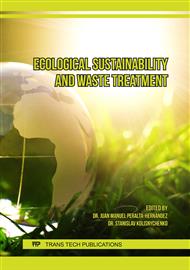p.498
p.506
p.511
p.519
p.525
p.531
p.536
p.542
p.546
Microalgae Biomass Recovery Grown in Wet Market Wastewater via Flocculation Method Using Moringa oleifera
Abstract:
Microalgae biomass has been established as a sustainable bio-product such as fish feed and supplement. However, the major challenge for recovering the biomass yield lies in the harvesting process. The recent direction is to use the natural coagulation as alternative techniques for the conventional methods. Therefore, the present study aimed to investigate the efficiency of Moringa oleifera in recovering Scenedesmus sp. biomass from wet market wastewater medium in comparison to Aluminium Sulphate (alum). The efficiency of alum and M.oleifera was tested with 10, 20, 30, 40 and 50 mg/L of the dosage. The results revealed that M.oleifera exhibited high percentage recovery of Scenedesmus sp. than alum (97.5 vs. 95.4 %respectively). Moreover, the final pH of microalgae cultured wastewater after the harvesting with M.oleifera was 6.4, while decreased to 4.37 with alum. These findings indicated that the using M.oleifera the using natural coagulants are better than the chemical coagulants in terms of recovery efficiency and the characteristics of wastewater. Therefore, M.oleifera has the potential to be used as a natural coagulants alternative for alum.
Info:
Periodical:
Pages:
542-545
Citation:
Online since:
July 2017
Keywords:
Price:
Сopyright:
© 2017 Trans Tech Publications Ltd. All Rights Reserved
Share:
Citation:



